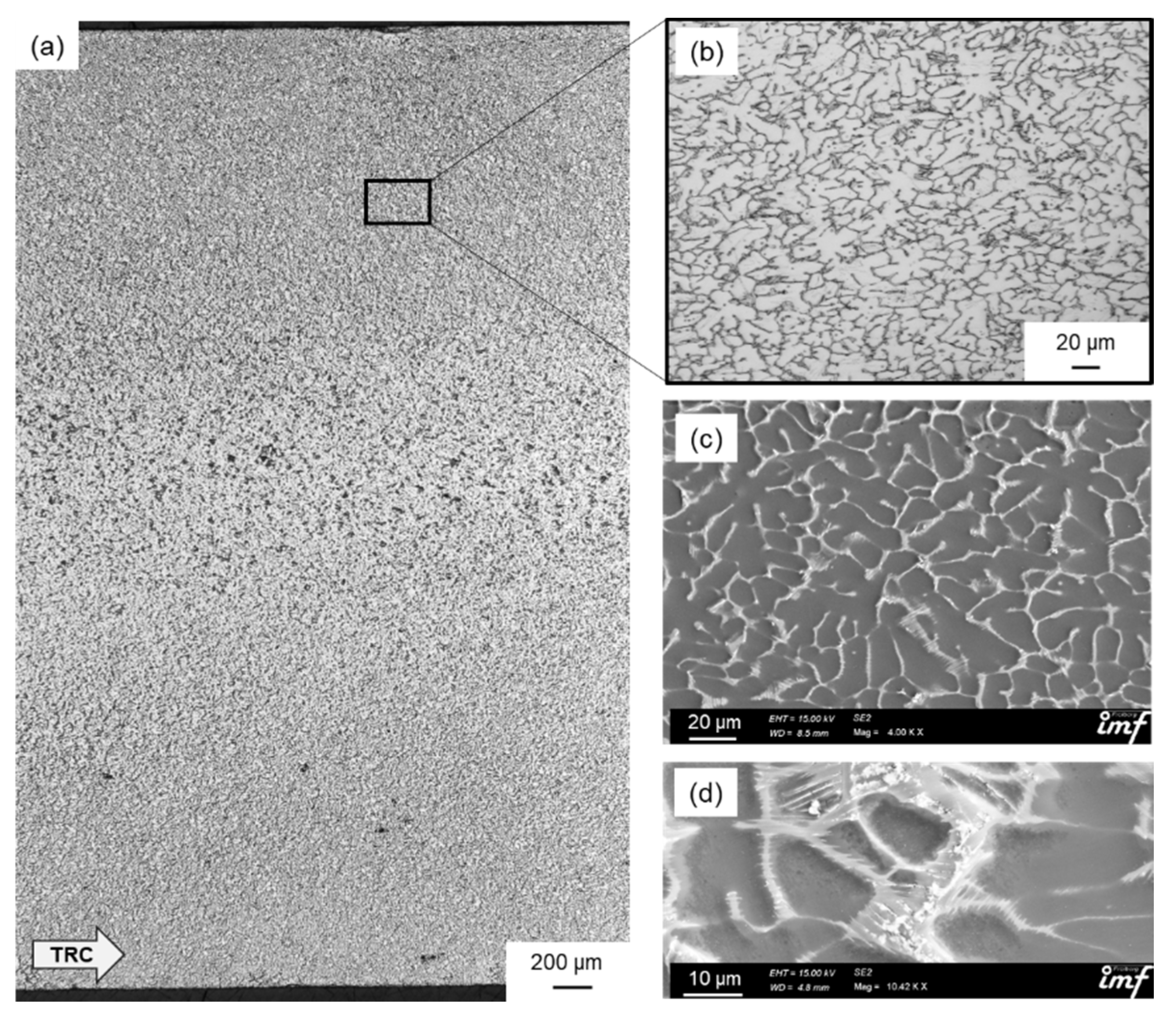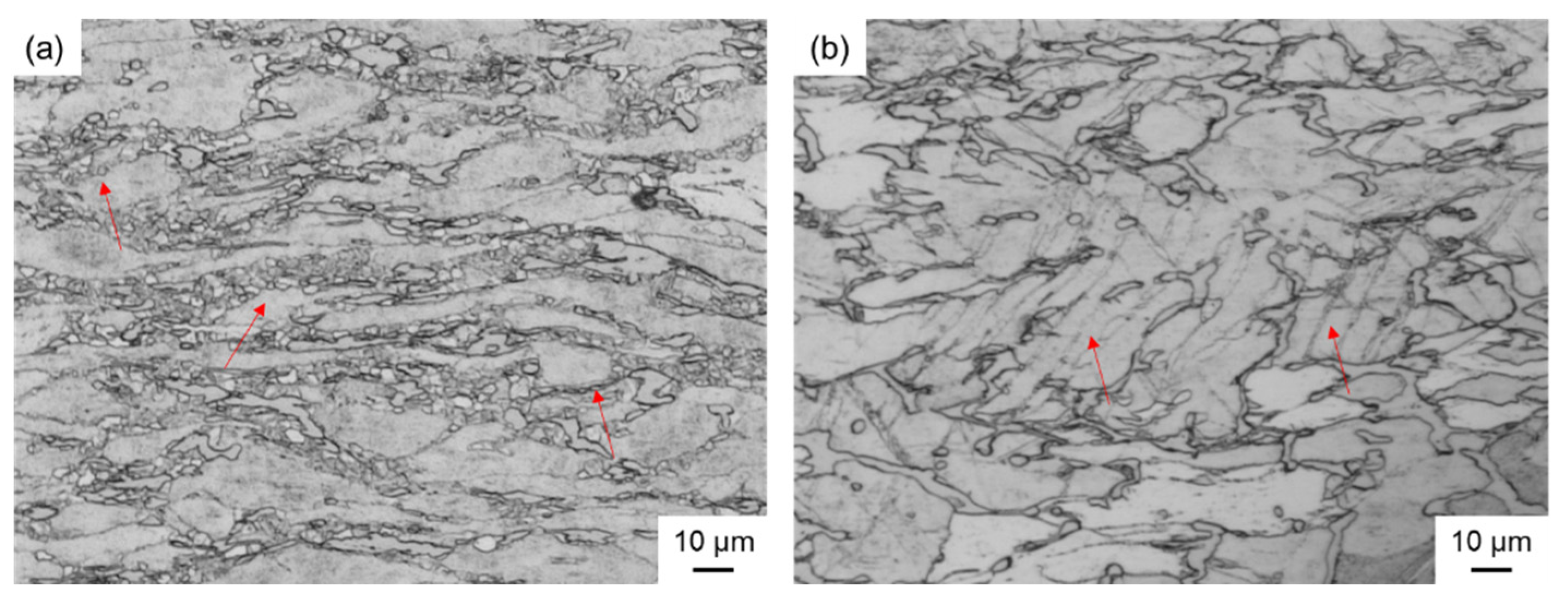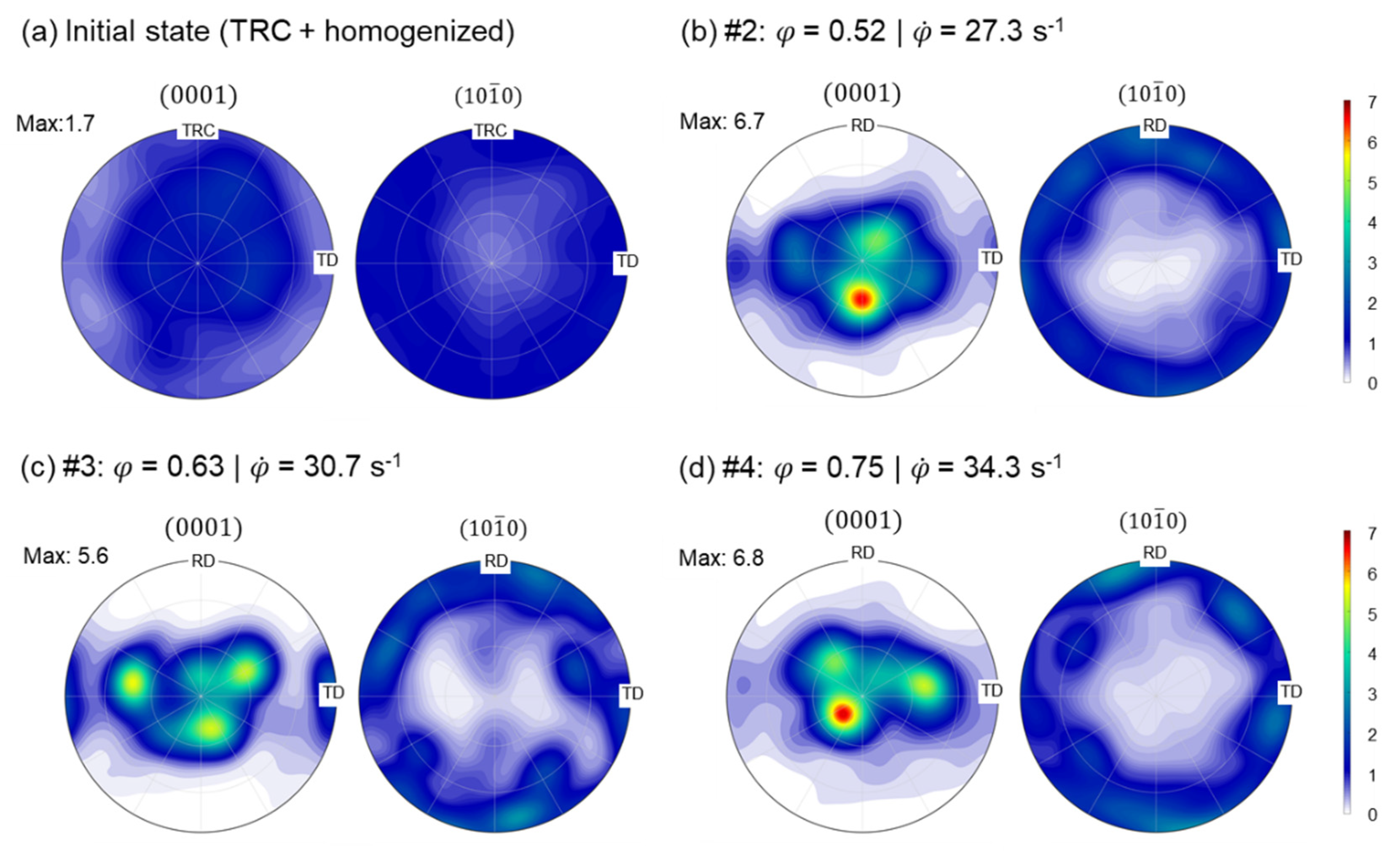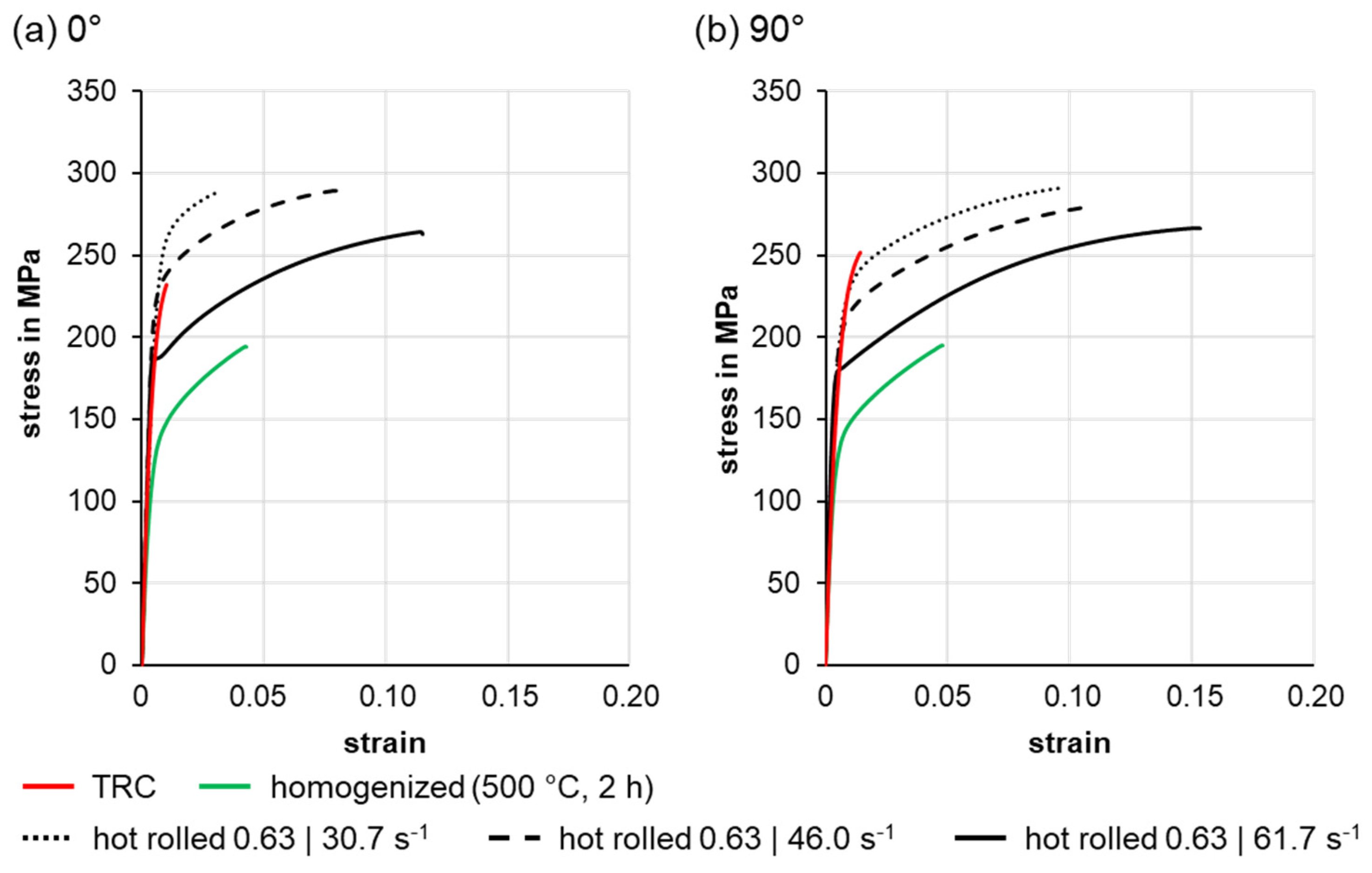Hot Rolling of the Twin-Roll Cast and Homogenized Mg-6.8Y-2.5Zn (WZ73) Magnesium Alloy Containing LPSO Structures
Abstract
:1. Introduction
2. Materials and Methods
3. Results and Discussion
3.1. Initial Material (Twin-Roll Cast and Homogenized WZ73 Alloy)
3.2. Hot Rolling
3.3. Microstructure of the as-Rolled WZ73 Alloy
3.4. Texture of the as-Rolled WZ73 Alloy
3.5. Mechanical Properties of the as-Rolled WZ73 Alloy
4. Conclusions
Author Contributions
Funding
Data Availability Statement
Acknowledgments
Conflicts of Interest
References
- Shao, X.H.; Jin, Q.Q.; Zhou, Y.T.; Yang, H.J.; Zheng, S.J.; Zhang, B.; Chen, Q.; Ma, X.L. Basal shearing of twinned stacking faults and its effect on mechanical properties in an Mg–Zn–Y alloy with LPSO phase. Mater. Sci. Eng. A 2020, 779, 139109. [Google Scholar] [CrossRef]
- Itoi, T.; Takahashi, K.; Moriyama, H.; Hirohashi, M. A high-strength Mg–Ni–Y alloy sheet with a long-period ordered phase prepared by hot-rolling. Scr. Mater. 2008, 59, 1155–1158. [Google Scholar] [CrossRef]
- Xu, C.; Zheng, M.; Xu, S.; Wu, K.; Wang, E.; Fan, G.; Kamado, S. Improving strength and ductility of Mg–Gd–Y–Zn–Zr alloy simultaneously via extrusion, hot rolling and ageing. Mater. Sci. Eng. A 2015, 643, 137–141. [Google Scholar] [CrossRef]
- Xu, C.; Zheng, M.Y.; Xu, S.W.; Wu, K.; Wang, E.D.; Kamado, S.; Wang, G.J.; Lv, X.Y. Ultra high-strength Mg–Gd–Y–Zn–Zr alloy sheets processed by large-strain hot rolling and ageing. Mater. Sci. Eng. A 2012, 547, 93–98. [Google Scholar] [CrossRef]
- Xu, C.; Nakata, T.; Qiao, X.; Zheng, M.; Wu, K.; Kamado, S. Effect of LPSO and SFs on microstructure evolution and mechanical properties of Mg-Gd-Y-Zn-Zr alloy. Sci. Rep. 2017, 7, 40846. [Google Scholar] [CrossRef]
- Neh, K.; Ullmann, M.; Kawalla, R. Mechanical Properties and Microstructure of the Magnesium Alloy Mg-6.8Y-2.5Zn-0.5Al Produced by Casting and Hot Rolling. Mater. Sci. Forum. 2018, 918, 3–12. [Google Scholar] [CrossRef] [Green Version]
- Ullmann, M.; Kittner, K.; Prahl, U. Hot Deformation and Dynamic Recrystallisation Behaviour of Twin-Roll Cast Mg-6.8Y-2.5Zn-0.4Zr Magnesium Alloy. Materials 2021, 14, 307. [Google Scholar] [CrossRef]
- Li, K.; Chen, Z.; Chen, T.; Jianbo, S.; Wang, R.; Liu, C. Hot deformation and dynamic recrystallization behaviors of Mg-Gd-Zn alloy with LPSO phases. J. Alloy. Compd. 2019, 792, 894–906. [Google Scholar] [CrossRef]
- Chen, R.; Sandlöbes, S.; Zehnder, C.; Zeng, X.; Korte-Kerzel, S.; Raabe, D. Deformation mechanisms, activated slip systems and critical resolved shear stresses in an Mg-LPSO alloy studied by micro-pillar compression. Mater. Des. 2018, 154, 203–216. [Google Scholar] [CrossRef]
- Alvarez-Lopez, M.; Pereda, M.D.; del Valle, A.J.; Fernandez-Lorenzo, M.; Garcia-Alonso, M.C.; Ruano, O.A.; Escudero, M.L. Corrosion behaviour of AZ31 magnesium alloy with different grain sizes in simulated biological fluids. Acta Biomater. 2010, 6, 1763–1771. [Google Scholar] [CrossRef] [Green Version]
- Lv, B.-J.; Peng, J.; Zhu, L.-L.; Wang, Y.-J.; Tang, A.-T. The effect of 14H LPSO phase on dynamic recrystallization behavior and hot workability of Mg-2.0Zn-0.3Zr-5.8Y alloy. Mater. Sci. Eng. A 2014, 599, 150–159. [Google Scholar] [CrossRef]
- Chen, T.; Chen, Z.; Shao, J.; Wang, R.; Mao, L.; Liu, C. The role of long period stacking ordered phase in dynamic recrystallization of a Mg–Zn–Y alloy during hot compression. J. Alloys Compd. 2020, 818, 152814. [Google Scholar] [CrossRef]
- Wang, L.; Jiang, J.; Liu, H.; Saleh, B.; Ma, A. Microstructure characterization and corrosion behavior of Mg–Y–Zn alloys with different long period stacking ordered structures. J. Magnes. Alloys 2020, 8, 1208–1220. [Google Scholar] [CrossRef]
- Wang, K.; Wang, J.; Peng, X.; Gao, S.; Hu, H.; Zeng, L.; Pan, F. Microstructure and mechanical properties of Mg-Gd-Y-Zn-Mn alloy sheets processed by large-strain high-efficiency rolling. Mater. Sci. Eng. A 2019, 748, 100–107. [Google Scholar] [CrossRef]
- Matsuda, M.; Ii, S.; Kawamura, Y.; Ikuhara, Y.; Nishida, M. Interaction between long period stacking order phase and deformation twin in rapidly solidified Mg97Zn1Y2 alloy. Mater. Sci. Eng. A 2004, 386, 447–452. [Google Scholar] [CrossRef]
- Yamasaki, M.; Hashimoto, K.; Hagihara, K.; Kawamura, Y. Effect of multimodal microstructure evolution on mechanical properties of Mg–Zn–Y extruded alloy. Acta Mater. 2011, 59, 3646–3658. [Google Scholar] [CrossRef]
- Kim, J.K.; Sandlöbes, S.; Raabe, D. On the room temperature deformation mechanisms of a Mg–Y–Zn alloy with long-period-stacking-ordered structures. Acta Mater. 2015, 82, 414–423. [Google Scholar] [CrossRef]
- Chen, R.; Sandlöbes, S.; Zeng, X.; Li, D.; Korte-Kerzel, S.; Raabe, D. Room temperature deformation of LPSO structures by non-basal slip. Mater. Sci. Eng. A 2017, 682, 354–358. [Google Scholar] [CrossRef]
- Garces, G.; Cabeza, S.; Barea, R.; Pérez, P.; Adeva, P. Maintaining High Strength in Mg-LPSO Alloys with Low Yttrium Content Using Severe Plastic Deformation. Materials 2018, 11, 733. [Google Scholar] [CrossRef] [Green Version]
- Shao, J.; Chen, Z.; Chen, T.; Liu, C. The Interaction Between {102} Twinning and Long-Period Stacking Ordered (LPSO) Phase During Hot Rolling and Annealing Process of a Mg-Gd-Y-Zn-Zr Alloy. Met. Mat. Trans. A 2021, 52, 520–530. [Google Scholar] [CrossRef]
- Chen, T.; Chen, Z.; Shao, J.; Wang, R.; Li, K.; Mao, L.; Liu, C. Interactions between kinking and {102} twinning in a Mg-Zn-Gd alloy containing long period stacking ordered (LPSO) phase. Mater. Sci. Eng. A 2019, 767, 138418. [Google Scholar] [CrossRef]
- Shiraiwa, T.; Tamura, K.; Enoki, M. Analysis of kinking and twinning behavior in extruded Mg–Y–Zn alloys by acoustic emission method with supervised machine learning technique. Mater. Sci. Eng. A 2019, 768, 138473. [Google Scholar] [CrossRef]
- Robson, J.D.; Stanford, N.; Barnett, M.R. Effect of precipitate shape on slip and twinning in magnesium alloys. Acta Mater. 2011, 59, 1945–1956. [Google Scholar] [CrossRef]
- Kittner, K.; Ullmann, M.; Arndt, F.; Kawalla, R.; Prahl, U. Microstructure and Texture Evolution during Twin-Roll Casting and Annealing of a Mg-6.8Y-2.5Zn-0.4Zr Alloy (WZ73). Crystals 2020, 10, 513. [Google Scholar] [CrossRef]
- Bachmann, F.; Hielscher, R.; Schaeben, H. Texture Analysis with MTEX—Free and Open Source Software Toolbox. Solid State Phenom. 2010, 160, 63–68. [Google Scholar] [CrossRef] [Green Version]
- Kittner, K.; Ullmann, M.; Arndt, F.; Berndorf, S.; Henseler, T.; Prahl, U. Analysis of defects in a twin roll cast Mg-Y-Zn magnesium alloy. Eng. Rep. 2021, 17, 177. [Google Scholar] [CrossRef]
- Chen, Q.; Xia, X.; Yuan, B.; Shu, D.; Zhao, Z.; Han, J. Hot workfability behavior of as-cast Mg–Zn–Y–Zr alloy. Mater. Sci. Eng. A 2013, 593, 38–47. [Google Scholar] [CrossRef]
- Ullmann, M.; Kittner, K.; Henseler, T.; Krbetschek, C.; Rafaja, D.; Kawalla, R.; Prahl, U. Dynamic recrystallization and texture evolution of Mg-6.8Y-2.5Zn-0.3Zr alloy during hot rolling. Procedia Manuf. 2020, 50, 809–816. [Google Scholar] [CrossRef]
- Itoi, T.; Inazawa, T.; Yamasaki, M.; Kawamura, Y.; Hirohashi, M. Microstructure and mechanical properties of Mg–Zn–Y alloy sheet prepared by hot-rolling. Mater. Sci. Eng. A 2013, 560, 216–223. [Google Scholar] [CrossRef] [Green Version]
- Kwak, T.Y.; Lim, H.K.; Kim, W.J. Hot compression behavior of the ignition-resistant Mg-5Y-2.5Zn-1.2Ca alloy with long-period stacking ordered structures. J. Alloys Compd. 2015, 632, 417–428. [Google Scholar] [CrossRef]
- Hagihara, K.; Fukusumi, Y.; Yamasaki, M.; Nakano, T.; Kawamura, Y. Non-Basal Slip Systems Operative in Mg12ZnY Long-Period Stacking Ordered (LPSO) Phase with 18R and 14H Structures. Mater. Trans. 2013, 54, 693–697. [Google Scholar] [CrossRef] [Green Version]
- Shao, J.; Chen, Z.; Chen, T.; Hu, Z.; Zhou, X.; Liu, C. The effect of LPSO on the deformation mechanism of Mg–Gd–Y–Zn–Zr magnesium alloy. J. Magnes. Alloys 2016, 4, 83–88. [Google Scholar] [CrossRef] [Green Version]
- Chen, Y.J.; Wang, Q.D.; Roven, H.J.; Liu, M.P.; Karlsen, M.; Yu, Y.D.; Hjelen, J. Network-shaped fine-grained microstructure and high ductility of magnesium alloy fabricated by cyclic extrusion compression. Scr. Mater. 2008, 58, 311–314. [Google Scholar] [CrossRef]
- Ma, Q.; Li, B.; Marin, E.B.; Horstemeyer, S.J. Twinning-induced dynamic recrystallization in a magnesium alloy extruded at 450 °C. Scr. Mater. 2011, 65, 823–826. [Google Scholar] [CrossRef]
- Xu, L.; Xiang, M.; Wang, J.; Zhang, J.; Wang, C.; Xie, C. Analysis and Characterization on Dynamic Recrystallization in Casting AZ31 Mg Alloys Under Plane Strain Compression. Materials 2020, 13, 522. [Google Scholar] [CrossRef] [Green Version]
- Garofalo, F. Fundamentals of Creep and Creep-Rupture in Metals; McMillan Series in Materials Science; McMillan Co.: New York, NY, USA, 1965. [Google Scholar]
- Liu, H.; Ju, J.; Yang, X.; Yan, J.; Song, D.; Jiang, J.; Ma, A. A two-step dynamic recrystallization induced by LPSO phases and its impact on mechanical property of severe plastic deformation processed Mg97Y2Zn1 alloy. J. Alloy. Compd. 2017, 704, 509–517. [Google Scholar] [CrossRef]
- Yu, J.; Zhang, Z.; Wang, Q.; Yin, X.; Ciu, J.; Qi, H. Dynamic recrystallization behavior of magnesium alloys with LPSO during hot deformation. J. Alloy. Compd. 2017, 704, 382–389. [Google Scholar] [CrossRef]
- Styczynski, A.; Hartig, C.; Bohlen, J.; Letzig, D. Cold rolling textures in AZ31 wrought magnesium alloy. Scr. Mater. 2004, 50, 943–947. [Google Scholar] [CrossRef]
- Steiner, M.A.; Bhattacharyya, J.J.; Agnew, S.R. The origin and enhancement of {0001}<110> texture during heat treatment of rolled AZ31B magnesium alloys. Acta Mater. 2015, 95, 443–455. [Google Scholar] [CrossRef]
- Bhattacharyya, J.J.; Agnew, S.R.; Muralidharan, G. Texture enhancement during grain growth of magnesium alloy AZ31B. Acta Mater. 2015, 86, 80–94. [Google Scholar] [CrossRef] [Green Version]
- Li, Z.; Liu, F.; Yuan, A.; Duan, B.; Li, Y.; Li, X. Effect of rolling deformation on microstructure and texture of spray-deposited magnesium alloy containing Mg-Nd-Zn typed LPSO. J. Mater. Sci. Technol. 2017, 33, 630–636. [Google Scholar] [CrossRef]
- Griffiths, D.; Davis, B.; Robson, J.D. The Influence of Strain Path on Rare Earth Recrystallization Textures in a Magnesium-Zinc-Rare Earth Alloy. Met. Mat. Trans. A 2018, 49, 321–332. [Google Scholar] [CrossRef] [Green Version]
- Kittner, K.; Ullman, M.; Henseler, T.; Prahl, U.; Kawalla, R. Dynamic recrystallization behavior of twin roll cast ZAX210 strips during hot deformation. In Proceedings of the 28th International Conference on Metallurgy and Materials, Brno, Czech Republic, 22–24 May 2019; pp. 1528–1534. [Google Scholar] [CrossRef]
- Al-Samman, T.; Gottstein, G. Influence of strain path change on the rolling behavior of twin roll cast magnesium alloy. Scr. Mater. 2008, 59, 760–763. [Google Scholar] [CrossRef]
- Al-Samman, T.; Gottstein, G. Dynamic recrystallization during high temperature deformation of magnesium. Met. Mat. Trans. A 2008, 490, 411–420. [Google Scholar] [CrossRef]
- Steiner, M.A.; Bhattacharyya, J.J.; Agnew, S.R. The relative contributions of deformation modes to AZ31 rolling textures in different temperature regimes. In Magnesium Technology 2017; Solanki, K.N., Orlov, D., Singh, A., Neelameggham, N.R., Eds.; Springer International Publishing: Cham, Switzerland, 2017; pp. 555–561. [Google Scholar]
- Ritzo, M.A.; Bhattacharyya, J.J.; Lebensohn, R.A.; Agnew, S.R. An investigation into the role of dislocation climb during intermediate temperature flow of Mg alloys. In Magnesium Technology 2020; Jordon, J.B., Miller, V., Joshi, V.V., Neelameggham, N.R., Eds.; Springer International Publishing: Cham, Switzerland, 2020; pp. 115–122. [Google Scholar]
- Matsuda, M.; Ando, S.; Nishida, M. Dislocation Structure in Rapidly Solidified Mg97Zn1Y2 Alloy with Long Period Stacking Order Phase. Mater. Trans. 2005, 46, 361–364. [Google Scholar] [CrossRef] [Green Version]
- Tahreen, N.; Zhang, D.F.; Pan, F.S.; Jiang, X.Q.; Li, D.Y.; Chen, D.L. Strengthening mechanisms in magnesium alloys containing ternary I, W and LPSO phases. J. Mater. Sci. Technol. 2018, 34, 1110–1118. [Google Scholar] [CrossRef]








| Y | Zn | Zr | Si | Fe | Cu | Ni | Others | Mg |
|---|---|---|---|---|---|---|---|---|
| 6.8 | 2.5 | 0.4 | 0.01 | 0.005 | 0.001 | 0.001 | 0.01 | Balance |
| Parameter of Hot Rolling | Parameter Range |
|---|---|
| equivalent strain | 0.43|0.52|0.63|0.75 |
| rolling speed in m/s | 1|1.5|2 |
| Sample Number | Rolling Speed in m/s | Initial Thickness in mm | Final Thickness in mm | in s−1 | Recrystallized Fraction in % | |
|---|---|---|---|---|---|---|
| 1 | 1 | 5.52 | 3.80 | 0.43 | 24.5 | - |
| 2 | 1 | 5.51 | 3.52 | 0.52 | 27.3 | >5 |
| 3 | 1 | 5.53 | 3.21 | 0.63 | 30.7 | 12 |
| 4 | 1 | 5.52 | 2.89 | 0.75 | 34.3 | 50 |
| 5 | 1.5 | 5.52 | 3.53 | 0.52 | 40.9 | 18 |
| 6 | 1.5 | 5.54 | 3.22 | 0.63 | 46.0 | 41 |
| 7 | 2 | 5.54 | 3.81 | 0.43 | 49.0 | 21 |
| 8 | 2 | 5.53 | 3.52 | 0.52 | 54.8 | 43 |
| 9 | 2 | 5.50 | 3.19 | 0.63 | 61.7 | 73 |
| 10 | 2 | 5.55 | 2.91 | 0.75 | 68.4 | 90 |
| Condition | 0° (RD) | 90° (TD) | ||||
|---|---|---|---|---|---|---|
| UTS in MPa | YS (0.2%) in MPa | A in % | UTS in MPa | YS (0.2%) in MPa | A in % | |
| TRC | 248 ± 2.5 | 195 ± 3.2 | 0.9 ± 0.3 | 255 ± 1.8 | 203 ± 2.6 | 0.9 ± 0.2 |
| 500 °C, 2 h | 195 ± 3.3 | 136 ± 1.8 | 3.6 ± 0.8 | 210 ± 3.4 | 127 ± 2.4 | 5.9 ± 1.1 |
| 0.63|30.7 s−1 | 292 ± 2.9 | 246 ± 1.4 | 3.0 ± 0.5 | 290 ± 2.9 | 202 ± 3.1 | 7.6 ± 1.2 |
| 0.63|46.0 s−1 | 285 ± 5.0 | 231 ± 2.5 | 6.1 ± 1.6 | 279 ± 2.0 | 198 ± 1.2 | 10.3 ± 1.2 |
| 0.63|61.7 s−1 | 269 ± 4.1 | 191 ± 3.7 | 12.4 ± 2.1 | 266 ± 0.8 | 181 ± 1.9 | 13.4 ± 1.0 |
Publisher’s Note: MDPI stays neutral with regard to jurisdictional claims in published maps and institutional affiliations. |
© 2021 by the authors. Licensee MDPI, Basel, Switzerland. This article is an open access article distributed under the terms and conditions of the Creative Commons Attribution (CC BY) license (https://creativecommons.org/licenses/by/4.0/).
Share and Cite
Ullmann, M.; Kittner, K.; Prahl, U. Hot Rolling of the Twin-Roll Cast and Homogenized Mg-6.8Y-2.5Zn (WZ73) Magnesium Alloy Containing LPSO Structures. Metals 2021, 11, 1771. https://doi.org/10.3390/met11111771
Ullmann M, Kittner K, Prahl U. Hot Rolling of the Twin-Roll Cast and Homogenized Mg-6.8Y-2.5Zn (WZ73) Magnesium Alloy Containing LPSO Structures. Metals. 2021; 11(11):1771. https://doi.org/10.3390/met11111771
Chicago/Turabian StyleUllmann, Madlen, Kristina Kittner, and Ulrich Prahl. 2021. "Hot Rolling of the Twin-Roll Cast and Homogenized Mg-6.8Y-2.5Zn (WZ73) Magnesium Alloy Containing LPSO Structures" Metals 11, no. 11: 1771. https://doi.org/10.3390/met11111771







